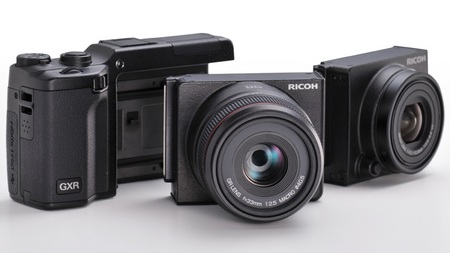
 By Gadjo Cardenas Sevilla
By Gadjo Cardenas Sevilla
Ricoh's GXR camera system was released in 2009 and offered a unique option to the interchangeable lens market by having multiple interchangeable sensors, lenses and image processors. While this system failed to gain the popularity enjoyed by Olympus, Panasonic, Sony, Samsung and others, users who have invested in the system are all praises on Ricoh's continuing support and firmware updates that improve the camera's performance.
 Most digital cameras are basically computers that run on firmware which is software that controls the features and functions of the camera and lens.
Most digital cameras are basically computers that run on firmware which is software that controls the features and functions of the camera and lens.
Most cameras will get one or maybe two firmware updates then the manufacturers will move to the next model with all new features.
Continuing firmware a year or two after the camera was launched is very rare because it cannibalizes sales of newer cameras set to replace the older model.
There are some rare exceptions, like Canon offering a large firmware update to its extremely popular EOS 7D DSLR, which is a model that it hasn't officially replaced with anything new.
Ricoh GXR, a cult classic
In the case of the Ricoh GXR system, there are a lot of reasons why it may not have gained the traction of its competitors. It is a more expensive system overall since you're buying multiple cameras instead of multiple lenses.
It is also quite hard to find since most traditional camera retailers in Canada don't carry it.
The main 'body' is actually a receptacle for the batteries and the LCD screen so you need to slide in various lenses and sensors which each cost $600. So, yeah, this isn't a system that will appeal to everyone.
Build quality is superior to most competing cameras in the market and the design is so sharp and smart that it doesn't look at all dated even sitting side by side with today's latest cameras.
The Ricoh GXR with the 28-300mm zoom lens is great for all around street photography
Users who have invested in the system, however, seem to love it. Many, like myself, found that it makes a great option for street photography or for travel because it is so small, has stunning image quality and can handle RAW photos as well as 720p HD video.
 The Ricoh GXR has also become very popular with users who like using lenses from other systems with adapters like the Leica M-Mount or Voigtlander lenses.
The Ricoh GXR has also become very popular with users who like using lenses from other systems with adapters like the Leica M-Mount or Voigtlander lenses.
While these can only be used in manual focus mode (preferred by most enthusiasts), it extends the life of thes lenses by giving them a large APS-C sized sensor in a compact body. The results are stunning.
Firmware for Fans
Ricoh has set an example in keeping customers happy. They have constantly listened to their users and integrated requested features and improvements.
The most recent Firmware update (version 1.51, the sixth update), was released in June this year. Three years after the GXR was introduced. Below is Ricoh's explanation on why they continue to refine the product.
"Ricoh's function-enhancing firmware updates are developed in response to opinions and requests received from a large number of customers via surveys submitted at customer registration time. These updates enable customers who already own a GXR to update their firmware to include the latest functions, thus making it possible for them to enhance the performance and usability of their cameras by adding new function and setting possibilities."
These firmware updates aren't 'fixes', rather they are mostly new features, refinements and enhancements that improve the user experience, photo quality and performance of the GXR system. They are extensive enough that it sometimes feels like you're getting a new camera after perfoming an update and really digging into the new features.
The series of firmware updates proves that Ricoh developed the system with a great deal of expansion and functionality in mind (which makes sense if it will continue to develop new modules to for users since these are essentially new cameras, so the firmware needs to make things work with all the new hardware).
It also shows that Ricoh is less focused on obsolescene and churning out new models every few months (on the contrary, it has taken its time to develop and release the various modules to expand the system).
Many manufacturers would have abandoned an unpopular system, they might have moved on and have had two or three new cameras by now but Ricoh has endured and continues to refine the experience on their superb but largely unnapreciated camera system. It really sets an example on how to keep exisiting custmers happy to own and use their products. Kudos to Ricoh!